Tuberous Sundew (Drosera) Cultivation



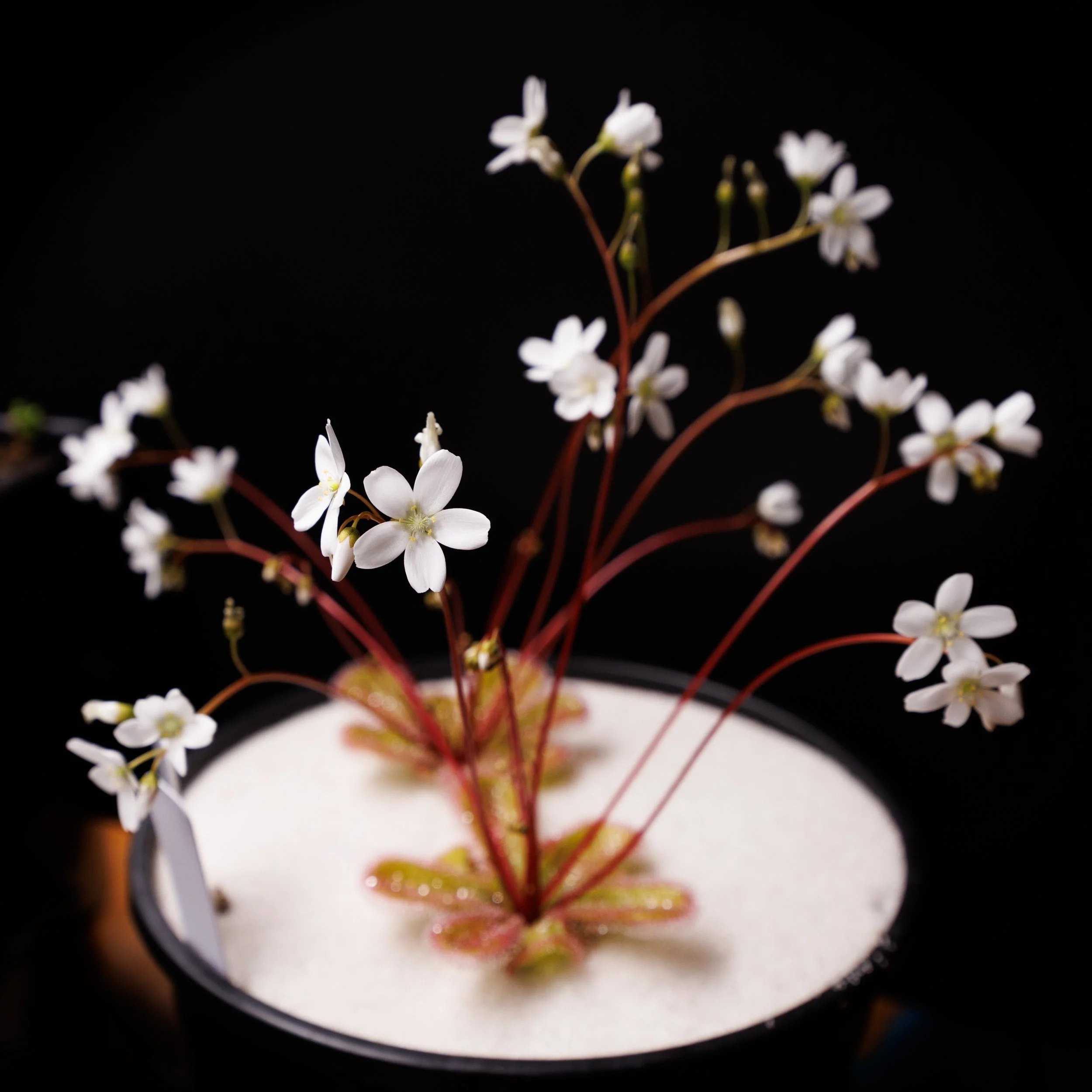
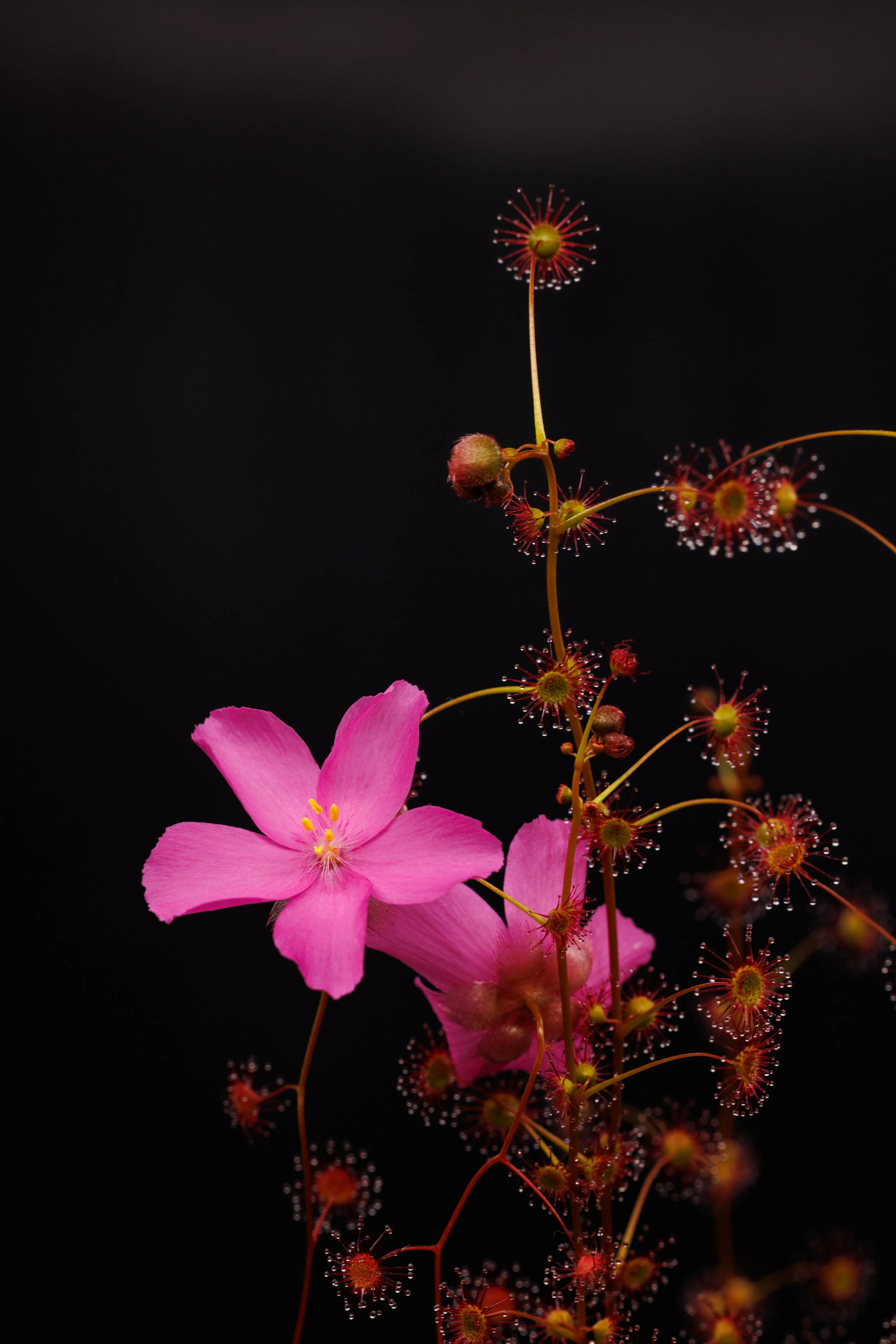

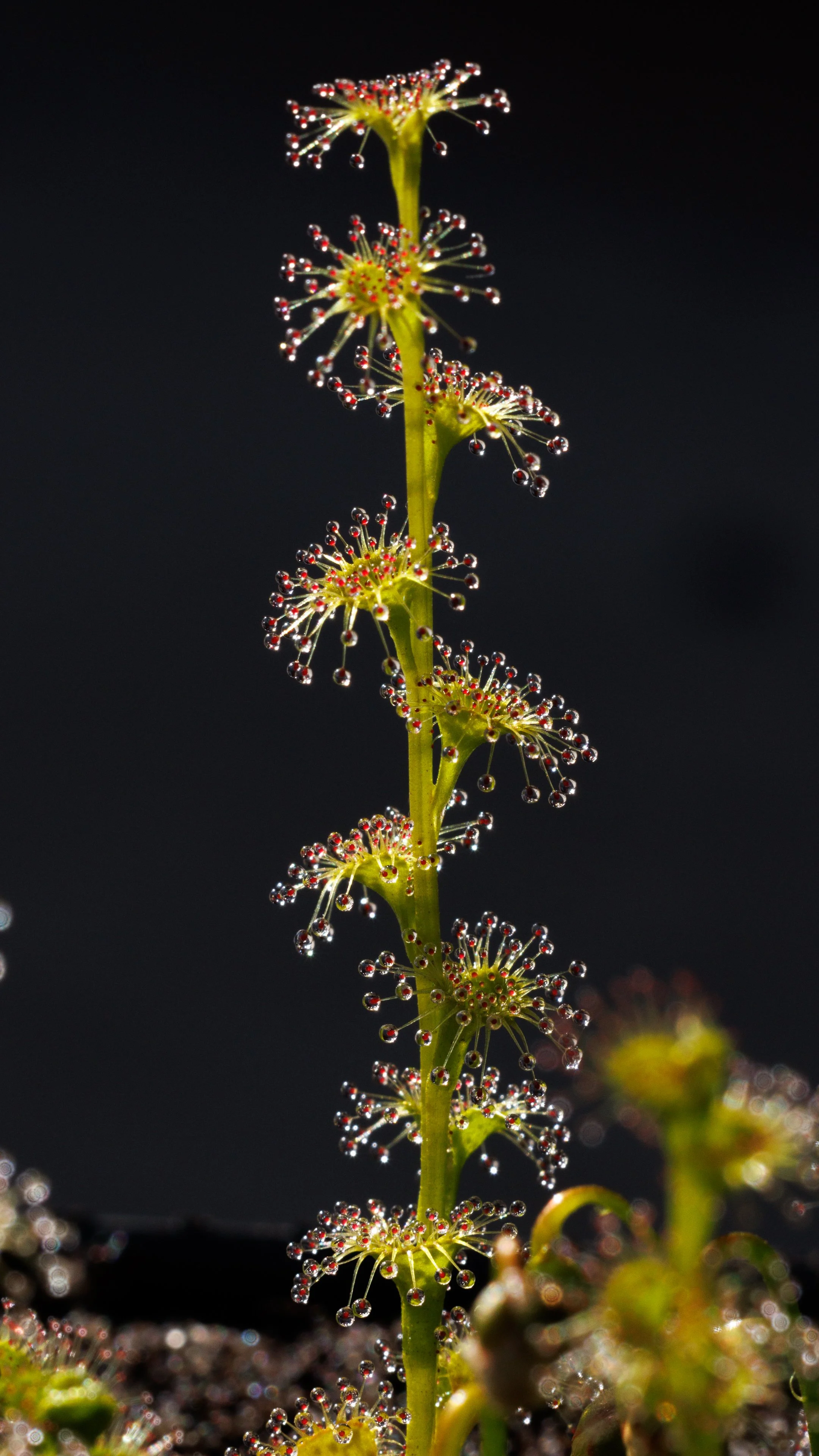
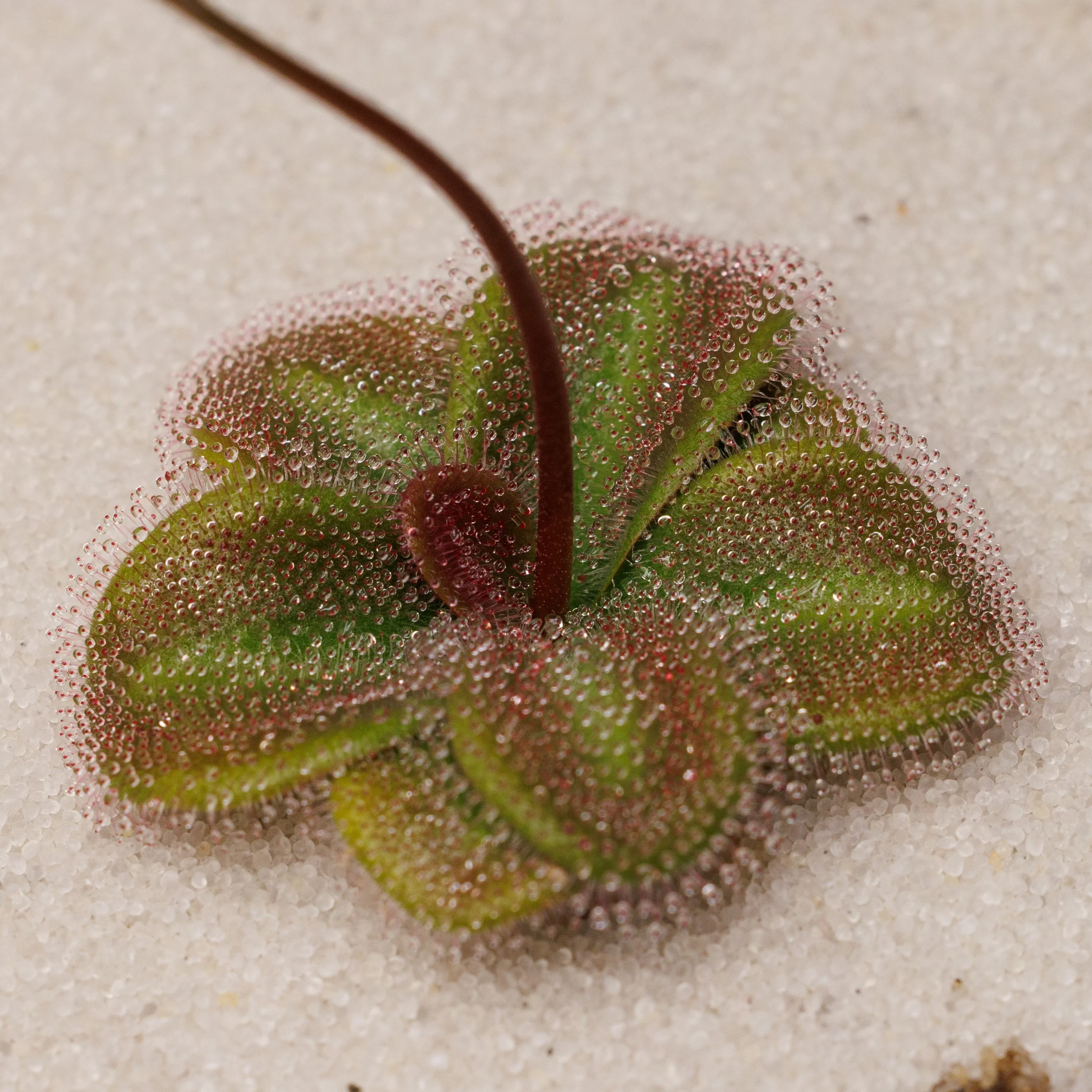
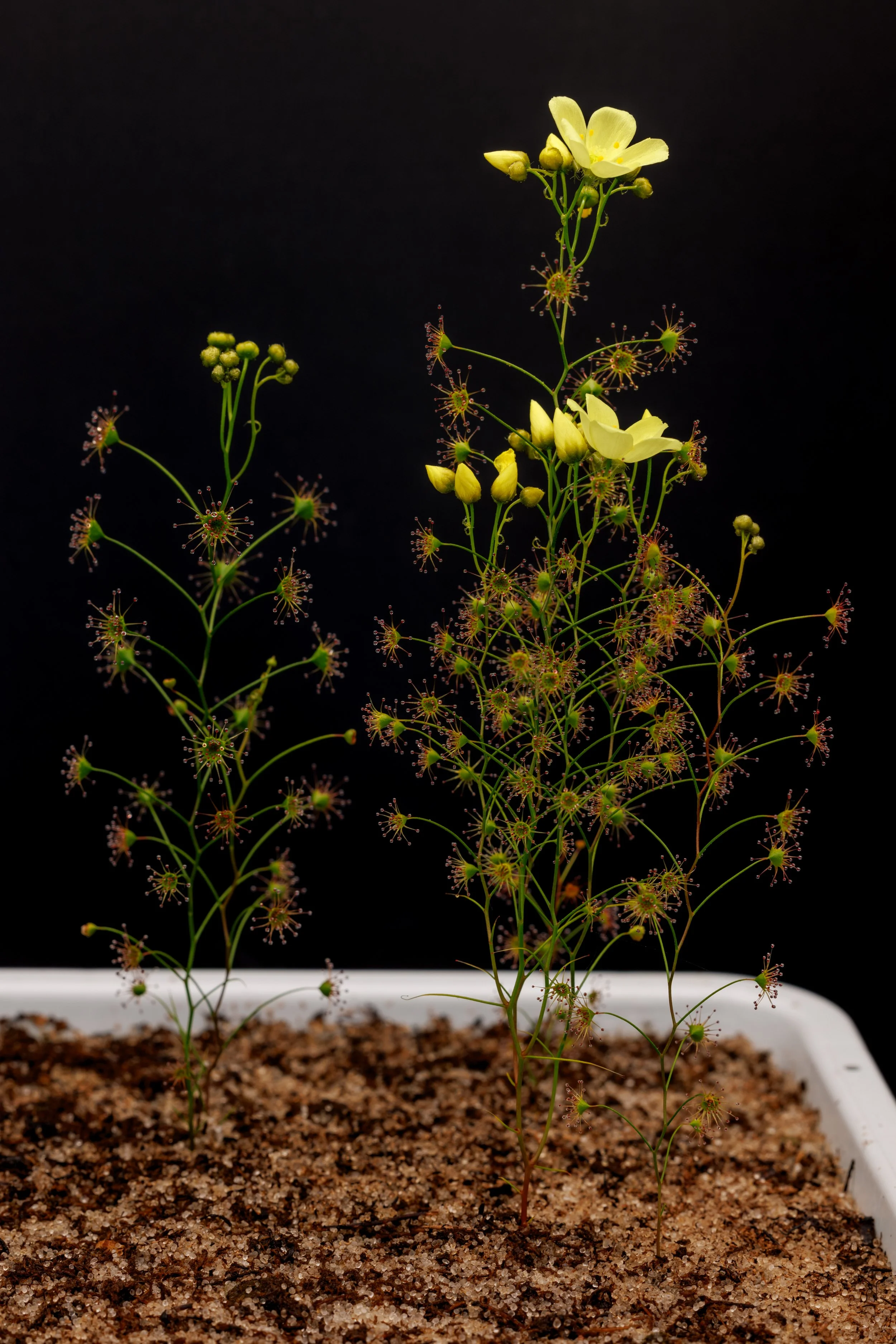
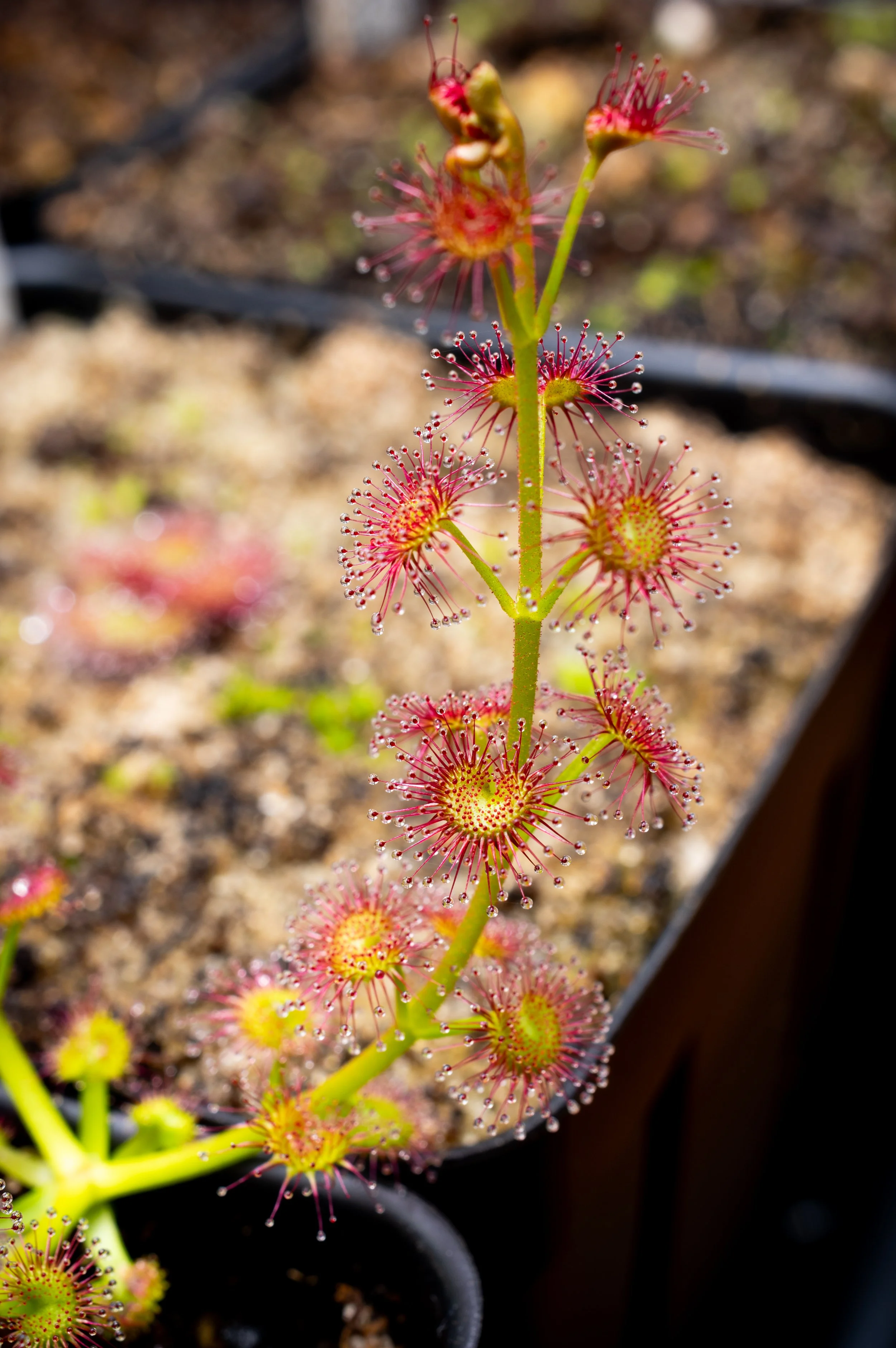
General Info:
Tuberous Sundews (Drosera subgenus. Ergaleium) are a diverse group of beautiful and unique Sundew species native to Southwestern Australia. They can be roughly grouped into 3 sections: the rosetted species (section Erythrorhiza), the fan-leaved species (section Stolonifera), and the erect or scrambling species (section Ergaleium). What defines this subgenus of incredible Sundews is their formation of underground tubers to survive and store energy during the harsh dry season. The Mediterranean climate of their home in Southwestern Australia (with rare exceptions extending into different habitats in New Zealand, New Guinea, or Asia) has cool and rainy winters, with dry and hot summers. The tubers are a specific adaptation to hide from the heat underground, and to preserve moisture and nutrients for growing in the wet season. There are comparable, winter-growing Sundews found in South Africa that have developed similar adaptations using fleshy roots to store energy during summer dormancy.
Because of the specific seasonality, growing these species in cultivation is one of the great challenges of carnivorous plant growing. However, the rewards are the most beautiful, unique, and ephemeral forms that transfix hobbyists and casuals alike. They will rapidly sprout and grow in the rainy winter months, and must feed and grow in this time to flower, then store energy in their tubers, then dry out and die back when the heat and drought of summer arrives. Maintaining tubers through dry summer dormancy is challenging enough, but getting germination out of seeds from many of the species is even harder. The general differences in species are as follows.
The rosetted species have round, flat leaves that form circular arrangements on the soil surface. The nuanced shape of the leaves, tentacle color, and geometric orientation give these species an appearance unique amongst all Drosera. Drosera squamosa may be the most famous of these with its red horseshoe of tentacles on dewy, round leaves. These are challenging to grow as they are first very difficult to germinate, and sensitive to heat. Other species like Drosera lowriei “Giant” are gems of the genus. They can produce dozens of flowers at the beginning of the growing season with powerful, perfumey aromas that can be a shock to many growers.
The fan-leaved species grow in a completely different orientation with short stems surrounded by semi-circular leaves. The dew drops can be exceptionally large on these leaves, and given the accelerated growth from the tuber, the entire plant can be vibrantly green to red and completely covered in glistening dew. These species also have large, difficult to germinate seed. (I cannot describe in words how these appear, so please look up photos in the links at the bottom.) Of these, I have found Drosera ramellosa to be one of the easier species to germinate and grow.
The erect or scrambling species grow vertical stems of circular or shield-shaped leaves that can either be self supporting, or eventually vining and climbing on surround vegetation. These are the easiest types of Tuberous Sundews to grow as many can germinate easily without special treatment and can be forgiving during dormancy. Flower colors can be diverse and beautiful. The largest species, Drosera gigantea, can form thin bushes of carnivorous leaves and is one of the largest Sundews in the world.
Cultivation of Tuberous Sundews is an incredibly nuanced sub-hobby of carnivorous plant growing. Most growers focus on tuberous species after succeeding at growing most other species of Sundew. While being proficient at growing Tuberous Sundews can take many years (or decades), getting started can be approachable for any grower that has successfully grown a diversity of Sundews. The basic principles are as follows:
Winter growing season must be moist, cool, and reasonably bright. Overly hot temperatures can cause early dormancy which can be fatal if tubers were not sufficiently produced. Proper photoperiod is necessary if growing under lights.
Summer dormancy is obligatory and plants must go dormant to survive. Tubers need time and conditions to form properly at the end of the growing season and should be stored nearly dry, but with tiny amounts of residual moisture.
Plants must have adequate nutrition to accumulate energy in the short growing season. Feeding is required.
Starting in around September and continuing to December (depending on conditions), the tubers will emerge from the surface with a tight bud and will quickly emerge with many fresh carnivorous leaves. Growing conditions can be slightly moist until the bud emerges when regular watering can begin. The soil should generally be drier than other Sundews and soils mixes should be very well draining and airy. They can sit in shallow trays of water during this time, but should also be in tall pots to keep the water table well below the surface. Temperatures should cycle daily from the 40’s or 50F’s at night to 60’s or 70F’s during the day. Light should be fairly strong to ensure adequate photosynthesis and growth. Feed plants regularly during early growth stages to stimulate strong growth.
Plants will grow extremely rapidly due to the short growing season. Continue feeding regularly to allow them to put on size and to have the energy to create large tubers later in the season. Some plants will send up multiple shoots, with some coming later in the growing season. Some species will flower immediately out of dormancy (before any leaves even emerge) while others will flower later in the season. Certain species like Drosera auriculata and Drosera gunniana will readily self pollinate and product lots of small, thin seed. However, most species do not readily self pollinate and require pollen from other plants.
Towards the end of the growing season (April-June), some species will naturally go dormant based on photoperiod and/or temperatures. However, some will refuse to go dormant unless specifically dried out. This is a psychological challenge to new growers as the plants generally look the most robust and beautiful at this time. Do not fall victim to this fallacy. Force them to go dormant or the tubers will die. To transition to dormancy, gradually dry out the soil over the next month or so. Aim for a continuously more dry soil as heavy rewetting may cause regrowth of the tubers. Large pots are beneficial for stability and gradual changes. Once the pots are almost entirely devoid of moisture, they can be stored somewhere cool and dark. Ensure they maintain a tiny amount of moisture as tubers can dessicate if overly dry. However, it is much easier to rot the tubers from too much moisture. This part takes practice, experience, and repeat failure to learn. Expect to lose tubers during dormancy, though ideally improvements in technique will reduce the losses each year.
Towards the later half of dormancy, tubers can send up a thin stem that will wait just below the surface for the right conditions. It is best to repot your tubers once pots are fully dry, but before they send up these shoots as they can be fragile and you do not want to damage it. Each tuber will have an “eye” that is a small bump on one side that designates where the shoot will form. This should be planted facing upward. Tuber depth can vary based on species, soil, and moisture. Typically, young tubers will be between 1-2” below the surface, with older tubers 3” deep or even much deeper. If you receive tubers, plant them between 1-3” deep depending on size and species.
Species: Drosera auriculata, Drosera gunniana, Drosera hookeri, Drosera macrantha, Drosera zigzagia, Drosera menziesii, Drosera macrophylla, Drosera stolonifera, Drosera porrecta, Drosera squamosa, Drosera tubaestylis…
Seed Germination
Germination of seeds is an art within itself. Some species require no special treatment or conditions and can germinate as easily as other Drosera seeds. Typically these are the species with very small seeds like Drosera auriculata, Drosera gunniana, Drosera menziesii, Drosera zigzagia, etc. Other species with large, hard, round seed are adapted to survive many years of harsh summers and even wildfires and are thus extremely resistant to germination. The evolutionary strategy is to maintain a seedbank in the soil that can emerge after fire, or will sporadically germinate to keep the population alive. Specialized treatment is needed to germinate these seeds. Heat, smoke, chemicals, mechanical scarification, and many more methods are attempted to improve germination. Heat treatment seems to be one of the most reasonable and successful methods, however it can be fully insufficient in some cases. Many species will germinate with a simple heat treatment in the summer that simulates seeds baking on the soil surface. I still have many tests and experiment to conduct to determine proper methods for the more difficult species. Some make require smoke, some may require especially cold temperatures (30F-40F) and proper temperature cycling to germinate.
To sow, seeds can be sprinkled onto the surface of moist media. I find slightly better germination with added humidity, however good airflow is still necessary to prevent fungus and rot. Plants should be fed early which will substantially accelerate growth (though overfeeding can cause death). I typically find slow growth in the first season when plants may be diverting more energy to tuber product than to vegetative growth (likely to help survival through the first difficult summer dormancy). These tubers can be very small and difficult to find the soil, so I typically leave them in their same pots until at least year 2 to avoid losing tubers during a repot.
Cultivation:
Lighting: Part to Full Sun or at least 15W per sq ft LED light. Tuberous Sundews like strong light, though do not require as much as other species due to their native winter sun levels.
Water: Distilled or Reverse Osmosis water. Sitting in 0.5”-1” of water using the tray method depending on pot height during active growth. Tuberous Sundews prefer very good drainage and do not want soggy conditions like other sundews. Watering must be tapered down as they approach dormancy to ensure proper tuber formation.
Climate: Temperatures from 40-75F with good airflow during the growing season. High temperatures can cause premature dormancy. Dormancy must be allowed or induced by drying out the soil around May and keeping it almost completely dry until ~October. Seasonal cues are strictly required, this is not optional!
Soil: In general, they can be grown in a <50% peat: >50% perlite/sand (though different species can prefer different mixes, check the individual pages). Deep pots are important to give space for the tubers and to manage moisture.
Feeding: Feed dewy leaves with Fish Food Powder or Insect Powder every 1-2 weeks or so.
Notes:
Different species will have different sensitivities.
No one has the same growing conditions so specific cultivation methods will vary between growers.
Tubers can be stored in bags over the summer, but need to have their moisture managed periodically.
Plants will form secondary tubers if they are healthy. This is the primary way that plants are propagated besides seed, but it is slow and thus the reason for the low availability of tubers.
More Information:
https://www.carnivorousplants.org/grow/guides/tuberousDrosera
https://www.carnivorousplants.org/cp/taxonomy/tuberousDrosera
http://www.growsundews.com/Tuberous_drosera/index.html